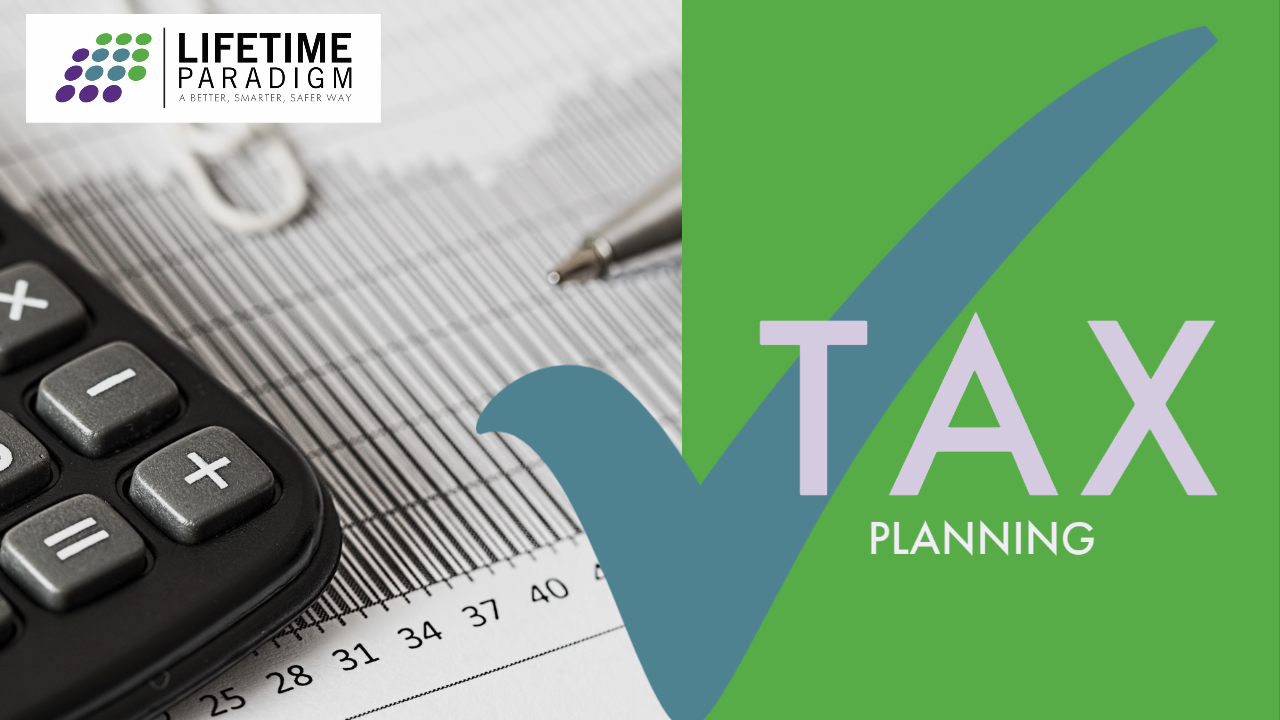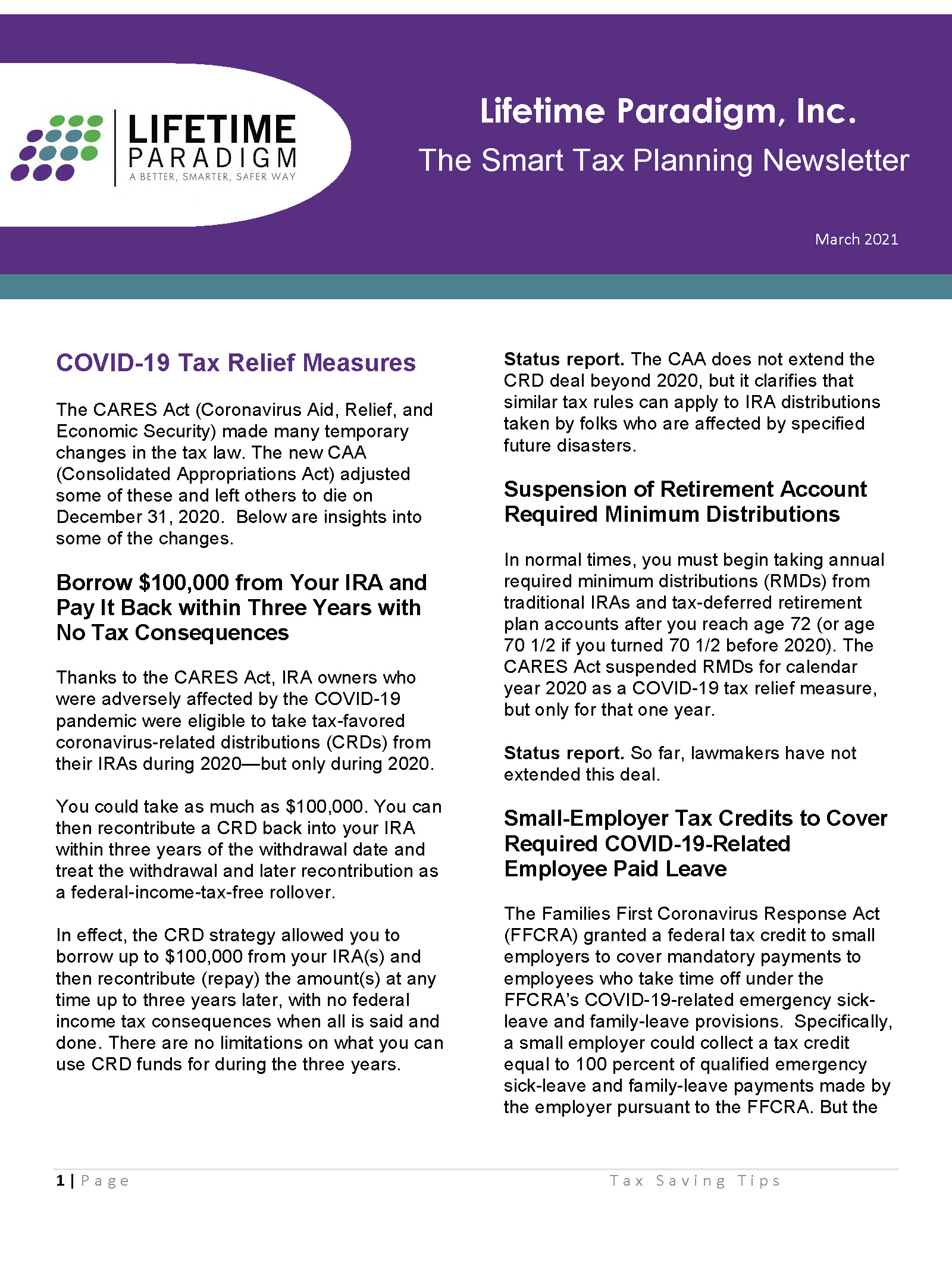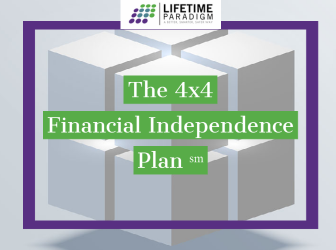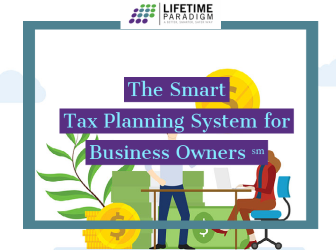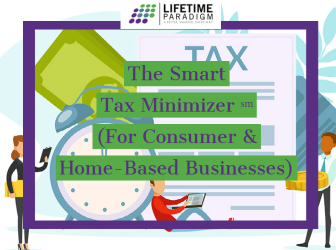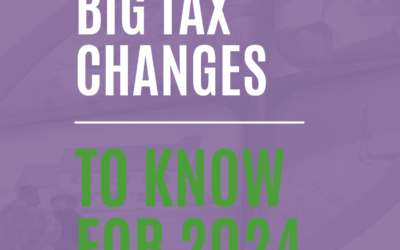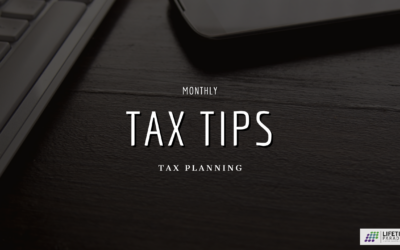Tax Planning
The Smart Tax Planning Newsletter March 2021
Every month we provide you with a fairly detailed review of several Important Tax Topics. Scan through the highlighted topics noted below.
In This Month’s Newsletter We Review:
- Covid-19 tax relief measures
- Business tax breaks thanks to the recently enacted CAA
- Deducting disaster losses for individuals
- Deducting disaster losses for businesses
COVID-19 Tax Relief Measures
The CARES Act (Coronavirus Aid, Relief, and Economic Security) made many temporary changes in the tax law. The new CAA (Consolidated Appropriations Act) adjusted some of these and left others to die on December 31, 2020. Below are insights into some of the changes.
Borrow $100,000 from Your IRA and Pay It Back within Three Years with No Tax Consequences
Thanks to the CARES Act, IRA owners who were adversely affected by the COVID-19 pandemic were eligible to take tax-favored coronavirus-related distributions (CRDs) from their IRAs during 2020—but only during 2020.
You could take as much as $100,000. You can then recontribute a CRD back into your IRA within three years of the withdrawal date and treat the withdrawal and later recontribution as a federal-income-tax-free rollover.
In effect, the CRD strategy allowed you to borrow up to $100,000 from your IRA(s) and then recontribute (repay) the amount(s) at any time up to three years later, with no federal income tax consequences when all is said and done. There are no limitations on what you can use CRD funds for during the three years.
Status report. The CAA does not extend the CRD deal beyond 2020, but it clarifies that similar tax rules can apply to IRA distributions taken by folks who are affected by specified future disasters.
Suspension of Retirement Account Required Minimum Distributions
In normal times, you must begin taking annual required minimum distributions (RMDs) from traditional IRAs and tax-deferred retirement plan accounts after you reach age 72 (or age 70 1/2 if you turned 70 1/2 before 2020). The CARES Act suspended RMDs for calendar year 2020 as a COVID-19 tax relief measure, but only for that one year.
Status report. So far, lawmakers have not extended this deal.
Small-Employer Tax Credits to Cover Required COVID-19-Related Employee Paid Leave
The Families First Coronavirus Response Act (FFCRA) granted a federal tax credit to small employers to cover mandatory payments to employees who take time off under the FFCRA’s COVID-19-related emergency sick-leave and family-leave provisions. Specifically, a small employer could collect a tax credit equal to 100 percent of qualified emergency sick-leave and family-leave payments made by the employer pursuant to the FFCRA. But the credit under the FFCRA covers only leave payments made between April 1, 2020, and December 31, 2020. Equivalent tax credit relief was available to self-employed individuals who took qualified leave between those dates.
Status report. The FFCRA expired by its terms on December 31, 2020. But the COVID-Related Tax Relief Act of 2020 (contained within the CAA) extends the small-employer credit to cover leave payments made between January 1, 2021, and March 31, 2021, that fall within the FFCRA framework.
There is no requirement for small employers to provide emergency sick-leave or family-leave payments after December 31, 2020. But between January 1, 2021, and March 31, 2021, employers can choose to make voluntary leave payments that fall within the FFCRA framework and can collect the credit if they do so.
Equivalent tax credit relief is available to self-employed individuals who take qualified leave between January 1, 2021, and March 31, 2021.
Liberalized Business Net Operating Loss Deduction Rules
Business activities that generate tax losses can cause you or your business entity to have a net operating loss (NOL) for the year. The CARES Act significantly loosened the NOL deduction rules and allows a five-year carryback for NOLs that arose in tax years 2018-2020.
So, an NOL that arose in 2020 can be carried back to 2015. NOL carrybacks allow you to claim refunds for taxes paid in the carryback years. Because tax rates were higher in pre-2018 years, NOLs carried back to those years can result in hefty tax refunds.
Status report. The CAA does nothing for NOLs that arise in tax years beginning in 2021—you can carry them forward only.
Suspension of Excess Business Loss Disallowance Rule
Before the CARES Act, the Tax Cuts and Jobs Act (TCJA) disallowed so-called excess business losses incurred by individuals in tax years beginning in 2018-2025. The TCJA defined an excess business loss as a loss that exceeds $250,000, or $500,000 for a married joint-filing couple. The $250,000 and $500,000 limits are adjusted annually for inflation.
The CARES Act suspended the excess business loss disallowance rule for losses that arose in tax years beginning in 2018-2020.
Status report. The CAA does nothing for excess business losses that arise in tax years beginning in 2021. As things stand, you effectively treat a 2021 excess business loss as an NOL that you can carry forward to future years.
Business Tax Breaks Thanks to the Recently Enacted CAA
When you operate a business, you have a variety of tax breaks available. The recently enacted CAA extends and expands some of the breaks. We bring the following selection of them to your attention as a tax-strategy buffet.
- You can deduct 100 percent of your business meals that are provided by restaurants in 2021 and 2022!!
- For hiring members of 10 targeted groups, you can obtain the work opportunity tax credit for first-year wages through 2025.
- You can now qualify for the 39 percent new markets tax credit for investments through 2025.
- The Empowerment Zone tax breaks that were scheduled to expire on December 31, 2020, are extended through 2025, but the new law terminates, for 2021 and later, both (a) the enhanced first-year depreciation rules and (b) the capital gains tax deferral break.
- Employers may continue through 2025 making Section 127 education plan payments that cover student loan principal and interest up to the plan maximum of $5,250.
- For residential rental property that you placed in service before 2018 and were depreciating over 40 years under the straight-line method, you can now use 30 years if you elect out of the TCJA business interest expense limitations.
- Farmers may elect a two-year NOL carryback rather than the five-year carryback retroactively, as if this change were in the original CARES Act.
- The $1.80 per-square-foot or $0.60 per-square-foot deductions for energy-efficient improvements to commercial buildings are now permanent.
- Small Business Administration Economic Injury Disaster Loan advances and loan repayment assistance are not taxable, and you suffer no tax attribute reductions as a result of the tax-free monies.
- Manufacturers of residential homes can claim a credit of $1,000 or $2,000 for homes that meet applicable energy-efficiency standards through 2021.
- Your business can claim a business federal income tax credit for up to 30 percent of the cost of installing non-hydrogen alternative-fuel vehicle refueling equipment (say, for your employees’ electric vehicles) through 2021.
- Your business can claim a federal income tax credit for buying vehicles propelled by chemically combining oxygen with hydrogen to create electricity, through 2021 (credits range from $4,000 to $40,000).
- The new law extends the seven-year recovery period to cover motorsports entertainment complex property placed in service through 2025.
- You can elect to claim the first-year write-off for the cost of qualified film, television, and theatrical productions commencing before 2025, subject to a $15 million per-production limit or a $20 million limit for productions in certain disadvantaged areas.
- For racehorses that are no more than two years old that you place in service during 2021, you may use three-year depreciation.
Deducting Disaster Losses for Individuals
We seem to be living in an age of natural disasters. Floods, fires, hurricanes, tornados, and other disasters often dominate the news. If a disaster strikes you, the tax law may help. When defined as such by the tax code, a disaster loss may qualify for deduction from your taxable income. The rules for personal losses are complex and far more restrictive than for business losses.
Only Casualty Losses Are Deductible
Damage to personal property caused by a disaster is deductible only if it qualifies as a casualty loss. A casualty is damage to, destruction of, or loss of property from events such as fires and floods that are sudden, unexpected, or unusual.
The disaster must result in physical damage to property, so economic losses due to the COVID-19 pandemic do not qualify as a casualty loss. Many, but not all, casualty losses are covered by insurance. The insurance recovery reduces your tax-deductible loss and could result in a taxable gain.
And here’s a possible nasty surprise. Say you have a deductible loss after reducing the loss by the insurance recovery. If you want to deduct the loss on your taxes, you must file a timely insurance claim, even if that insurance claim will result in the cancellation of your policy or an increase in premiums.
Your casualty loss (not your deduction) is equal to the lesser of
- the decrease in the property’s fair market value after the disaster, or
- the property’s adjusted basis before the disaster (usually its cost).
Subtract any insurance or other reimbursement from the lesser of these two options. To find the decline in the property’s fair market value, you can use an appraisal or the repair costs.
Limits on Casualty Losses
Unfortunately, you can’t deduct all your casualty losses. From 2018 through 2025, you can deduct personal casualty losses only due to a federally declared disaster or to the extent you have casualty gains.
For example, a homeowner can claim a casualty loss if a wildfire (declared a federal disaster) destroys his home. But he gets no deduction if a faulty fireplace caused the fire and destroys his home (no federal disaster).
The law imposes major limits on your casualty-loss deduction. The general rule says that you first reduce the loss by $100 and deduct the remaining loss only to the extent it exceeds 10 percent of your adjusted gross income (AGI). Your final hurdle is that claim the loss as an itemized deduction. These rules significantly reduce or even eliminate many casualty loss deductions.
Fortunately, some casualty losses are not subject to these limits, including disaster losses sustained due to a federally declared major disaster from January 1, 2020, to February 25, 2021. Instead, losses from such disasters are subject to a $500 floor with no 10-percent-of-AGI reduction. Under this rule, you deduct the loss whether or not you itemize. If you don’t itemize, you add the deductible loss to your standard deduction.
You have a choice for losses from a federal disaster: claim the loss in the year of the disaster or on the prior year’s return if it’s before October 15. This can result in a quick refund of all or part of the tax you paid that year.
Casualty Gains
If all this is not complicated enough, there’s one further wrinkle. A casualty such as a fire can result in a casualty gain instead of a casualty loss when the insurance proceeds you receive exceed the property’s adjusted basis (cost).
A casualty gain is taxable. But you may deduct casualty losses from the gains. Here, you don’t need a federal disaster. Also, you can postpone tax on a casualty gain by buying replacement property.
Deducting Disaster Losses for Businesses
Disasters such as storms, fires, floods, and hurricanes damage or destroy property. If property such as an office building, rental property, a business vehicle, or business furniture is damaged or destroyed in a disaster, your business may qualify for a casualty loss deduction. It’s easier to deduct business casualty losses than personal losses, but the rules are complex.
What Business Casualty Losses Are Deductible
Disasters such as fires and floods can result in a “casualty” because the damage, destruction, or property loss is from a sudden, unexpected, or unusual event. Car accidents qualify as a casualty so long as they’re not caused by your willful act or willful negligence. Losses due to thefts and vandalism can also qualify.
Insurance covers many casualty losses. You must reduce your casualty loss by the amount of any insurance you receive or expect to receive. But unlike with a personal loss, you are not required to file an insurance claim for a business casualty loss. You may wish not to do so if it will result in your policy’s cancellation or an increase in premiums.
Amount of Business Casualty Loss
Your casualty loss can never exceed the adjusted basis of the property involved—usually its cost plus the value of any improvements, minus all deductions you took for the property, including depreciation or Section 179 expensing. If your adjusted basis is zero, you get no casualty loss deduction and could have a casualty gain.
The amount of your casualty loss for damaged property is equal to the smaller of:
- the decrease in the property’s fair market value after the disaster, or
- the property’s adjusted basis before the disaster.
Subtract any insurance or other reimbursement received from the smaller of these two options.
You can use an appraisal or repair costs to figure the decline in the property’s fair market value. If a casualty destroys business property, the loss is equal to the property’s adjusted basis minus salvage value and insurance proceeds, if any.
Unlike personal casualty losses, business casualty losses are not subject to either (a) the $100 floor or (b) the 10-percent-of-AGI threshold to be deductible.
Business Casualty Losses Due to Federal Disasters
If your casualty loss is due to a federally declared disaster, you have the option of deducting it in the prior year. This way, you can get a refund of all or part of the tax you paid for that year.
Casualty Gains
You’ll have a casualty gain if the insurance proceeds you receive exceed the property’s adjusted basis (cost).
A casualty gain is taxable. But you can postpone tax on a casualty gain by buying replacement property of equal or greater value within two years (four years for federal disasters).
Repair Costs
Repairs of property damaged by a casualty are not part of the casualty loss deduction. You capitalize the cost of the repairs and add them to your basis in the damaged property. But then they may qualify for depreciation or Section 179 expensing.
IMPORTANT
The information contained in this newsletter is for general use and educational purposes only.


For more information on tax planning, visit our Tax Planning page to see our list of services.
Big Tax Changes to Know for 2024
Financial Guides2024 has brought some big tax changes with it. It’s essential to stay informed about these...
The Smart Tax Planning Newsletter March 2024
Tax PlanningIn This Issue: IRAs for Young Adults Get Up to $32,220 in Sick and Family Leave Tax Credits New Crypto Tax...
2024 Key Planning & Investment Deadlines for Q2
Financial GuidesSpring is coming and to keep you financially organized for Q2, we are providing you with our Spring...

